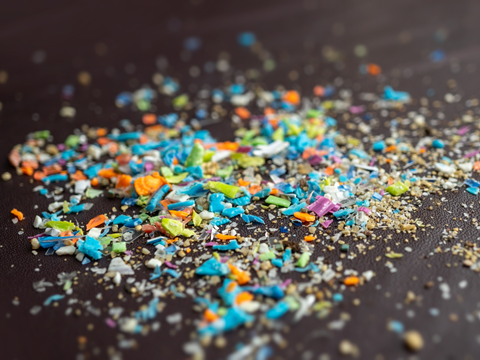
Brightly coloured plastics break down into microplastics at a faster rate than those in plainer colours, according to researchers from the University of Leicester and the University of Cape Town.
Published in the journal Environmental Pollution, the findings used two complementary studies to demonstrate that, depending on the colourant used to formulate them, plastics of the same composition could degrade at different rates.
In one study, bottle lids of various colours were placed on the roof of a university building, where they were exposed to the sun and the elements for three years. A second utilized plastic items of different colours from a remote beach in South Africa.
In both cases, samples were only used if a date stamp was embossed into the plastic, revealing its date of manufacture.
Fourier-transform infrared spectroscopy (FTIR) was used to gauge how much the plastics had reacted with oxygen in the air, and thus how far they had chemically degraded. A breaking strength test was also conducted before and after the study to measure the plastics’ structural integrity.
The researchers found that blue, green, and red samples became brittle and fragmented, while black, white, and silver plastics remained mostly intact. Apparently, older samples found in South Africa were all plain colours, but microplastics of many colours were observed in the sand.
Therefore, the research posits that black, white, and silver colourants protect plastics against ultraviolet (UV) radiation in ways that other pigments do not. Such damage changes the polymer structure of a plastic, which makes it brittle and more likely to fragment.
Little is known for certain about the environmental impact of microplastics, the researchers explain, but their properties are different from their original bulk materials. They can cause toxic plastic additives to leak into the environment; and the microplastics themselves, as well as toxic chemicals on their surfaces, can enter the human body via the food chain and water supplies.
The universities’ research is thought to be the first time the effect of colourants on plastic degradation has been proven in a field study. Retailers are encouraged to consider the results when designing packaging and other plastics.
Dr Sarah Key led the research as a PhD student at the University of Leicester School of Chemistry, funded by CENTA – The Central England NERC Training Alliance. Dr Key is now a senior research analyst at WRAP.
She commented: “It’s amazing that samples left to weather on a rooftop in Leicester in the UK and those collected on a windswept beach at the southern tip of the African continent show similar results.
“What the experiments showed is that even in a relatively cool and cloudy environment for only three years, huge differences can be seen in the formation of microplastics. Colourful plastics, such as red and green, degrade and form microplastics pretty quickly. When you look at more plain colours, such as black and white, they’re actually quite stable and remain intact.
“Next time you clean up some plastic litter, take note of the colour and think about how soon it would have otherwise broken down. Whatever the colour, always check the packaging for details of how to recycle plastic packaging.
“Manufacturers should consider both the recyclability of the material and the likelihood of it being littered when designing plastic items and packaging. For items that are used outdoors or extensively exposed to sunlight, such as plastic outdoor furniture, consider avoiding colours like red, green and blue to make them last as long as possible.
“Where the plastic is designed to break down, such as by using pro-oxidant additives, consider the role that colour could play in this.”
Co-author Professor Sarah Gabbott from the University of Leicester School of Geography Geology and the Environment added: “I’ve often wondered why microplastics in beach sand often appear to be all the colours of the rainbow. Until our study, I assumed that my eyes were being deceived and that I was just seeing the more colourful microplastics because they were easier to spot.
“Turns out there really are likely to be more brightly-coloured microplastics in the environment because those plastic items pigmented red, green and blue are more susceptible to being fragmented into millions of tiny, yet colourful microplastic particles.”
In another project, scientists at King’s College London claim to have harnessed an enzyme often found in biological laundry detergents to degrade and recycle single-use bioplastics used in coffee cups and food containers. Reportedly, the process breaks bioplastics down into soluble fragments within 24 hours, compared to the twelve weeks it takes in industrial composting conditions.
SYSTEMIQ has also published a report envisioning fifteen global policy interventions that, in its view, could reduce the leakage of microplastics into the environment by 2040 – yet the action plan is still feared to mismanage 5Mt of microplastics.
If you liked this story, you might also enjoy:
How are the top brands progressing on packaging sustainability?
The ultimate guide to global plastic sustainability regulation
















No comments yet